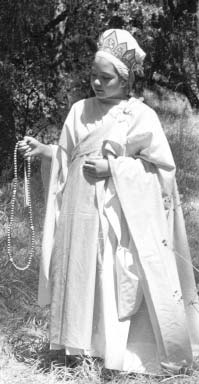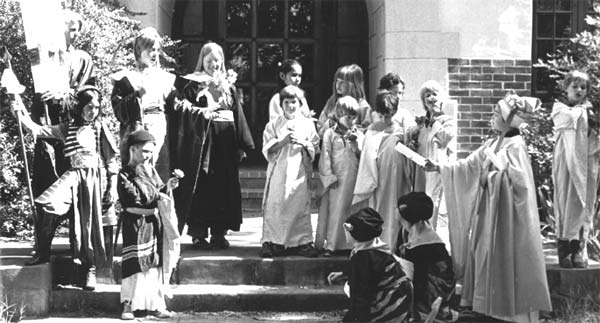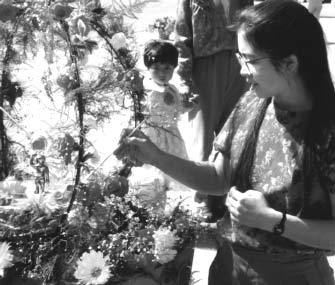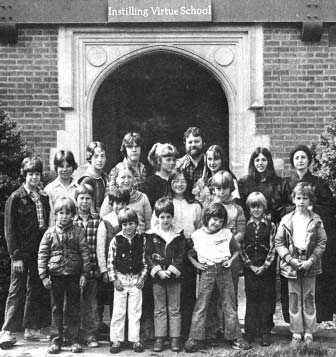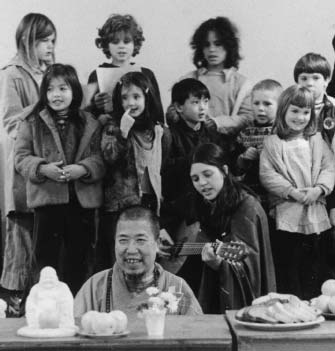
Children
of Instilling Virtue School performing for Shr Fu
at Gold Mountain Monastery in San Francisco
(Shari 2nd row left) Photo by Marion Robertson
GROWING UP AT THE CITY OF 10,000 BUDDHAS
INTERVIEW WITH SHARI RUEI-HUA EPSTEIN
The City of Ten Thousand Buddhas was my whole world when
I was growing up. I remember trying to tell one of my classmates
in college about it. I went on for about half an hour, and
then he said, “I have no idea what you are talking about.
I can’t even imagine that kind of community.” My
heart sank. I realized that what had been such a central,
dominant and treasured experience in my life was marginal,
strange, and inaccessible to most people.
My earliest memories are of attending Sutra lectures with
my parents. (Sutras are Buddhist scriptures). Every evening
we would go to the temple, and I would play with the other
kids while the adults chanted and then listened to our teacher,
Master Hsuan Hua, give Dharma talks (lectures on Buddhist
teachings). Master Hua was a respected, high monk in Asia
but nothing about him made that obvious to me. From my point
of view he was a kindly older monk whom everyone called Shr
Fu, a Chinese term meaning literally “teacher-father.”
My parents used to drive Master Hua back and forth from where
he lived to the lecture hall, so I got to spend quite a bit
of time with him at a very young age. I always thought of
him as a grandfather, a member of the family. He was very
accessible but could also be stern. He would always carry
candy in the long sleeves of his robes to give to the children.
I remember once my friends and I followed him all the way
up to his room in hopes of getting more candy, and he scolded
us for being too greedy. I felt deeply ashamed and will never
forget his teaching. However, I never had the sense of being
scared of him. He was someone who was incredibly compassionate
and to whom you could always talk and who was very, very wise.
I think I took his presence for granted because for all of
my life he had always been there. I don’t know if all
children feel that way about their grandfathers, this complete
trust and confidence, feeling like there was someone there
you could always talk to about things. In elementary school
and even up through college, if there was something that I
was really seriously thinking about or was troubling me, I
would go and talk with him about it.
Master Hua encouraged me, and I got the impression very early
on that we were important as children, and as human beings,
that we could make a contribution. We were encouraged to do
whatever we could to fulfill our potentials—men and women,
lay people, monks, old and young, everyone should do this.
This was just standard.
When I was in elementary school, Master Hua started teaching
a matching couplets course in the morning. This is a form
of traditional Chinese poetry where one person writes a line,
and someone else has to match it. If the children wrote their
matches in English, someone would translate them into Chinese,
and then we’d go up and write our line on the blackboard.
He took everyone seriously—the five-year-old as well
as the forty-year-old head monk. Every once in awhile he would
let the kids sit in front of all the monks and nuns in the
lecture hall. This is not what you do in a traditional temple
where there is a strict hierarchy.
The way things are done at the City of Ten Thousand Buddhas
is very traditional, strict, and conservative in many ways.
The monks and nuns follow strict monastic rules: they eat
one meal a day, sleep sitting up, and follow a rigorous schedule.
Yet, Shr Fu was very flexible, innovative, and had a humorous
spirit about him. In monasteries, usually the abbot gives
all the lectures and everyone comes to hear him, but Shr Fu
had a system where he would speak last or sometimes not at
all. Sometimes he would draw straws. It was like a game. One
nun would speak, then one monk would speak, then one laywoman
and one layman. This was a very good model. In traditional
Buddhism men are higher in the hierarchy. Here, everything
was very democratic and equal. At the end, someone would be
chosen to go up to give a review or critique, and then perhaps
Shr Fu would talk. His comments were very down to earth—not
esoteric, scholarly, or obscure. He always focused on how
to put the Dharma into practice and how to be a good person.
There was this constant spirit of inquiry, not accepting things
on faith but constantly questioning and thinking for yourself.
That made a very strong impression on me when I was little.
|
|
|
|
|
“Three
Cart Patriarch” performed by students of Instilling
Virtue School at City of Ten Thousand Buddhas in 1981.
Emperor Hsuang-Tsang (played by Shari in both photos)
returns from India with the Buddhist Sutras. Photos
supplied.
|
The creative and innovative spirit that infused the traditional
Chinese practice of giving Sutra lectures was extended to
our education as well. As kids, we were also encouraged to
give lectures in the Buddha Hall. Even if we were scared to
do it at first, we were kindly encouraged, and once we did
it a few times it became more natural. Another highlight of
my elementary school days was putting on Buddhist musicals.
Our teachers would adapt stories from the Sutras into plays
and one of the nuns would write songs to go with them. It
was great to learn about Buddhism in this way. We even made
one of our plays—The Three Cart Patriarch—into a
record. The whole class got to go to a recording studio to
record it. Although we didn’t have all the activities
that a ritzy private school might have and most of our teachers
were volunteers, we had excellent instruction. One of my favorite
classes was art with Flory Chow (cover artist, Grace Millennium,
Issue 1) who taught us sculpture, drawing and painting. I
remember doing an acrylic painting of a northern Californian
Buddha sitting under a redwood tree. Our learning about Buddhism
wasn’t just book learning. We did a lot of different
creative activities, and we had many opportunities to interact
with the monks and nuns and participate in the activities
of the monasteries.
|
|
|
Shari
Bathing the Buddha, Wesak 1992 Photo by Marion Robertson
|
Once when I was young, there was a world religions conference
at the City of Ten Thousand Buddhas with representatives from
different religions. Some fundamentalist Christians set up
camp on Talmage Road with huge protest signs. It scared me
that they were protesting, because I didn’t realize that
anyone would find our community objectionable. Without telling
anybody, Shr Fu rode out in his little golf cart and talked
to them in English—something he did not usually do. He
said it was really hot out here standing in the sun and invited
them to protest under the trees near the monastery. I guess
this really shocked the people who were protesting. Some of
them didn’t want to come in and they left, but others
were moved and ended up coming in, going to the conference
and having lunch. After lunch, they talked about what had
happened, about Shr Fu going out and inviting them in. He
told them, “You can come and protest under the trees;
you can also come to the conference and say what you want
to say. You don’t have to stand out here.” Some
came in and talked about what they had thought when they were
protesting, and then how that changed. I thought, “Wow,
how amazing! Shr Fu wasn’t worried about his safety,
and he didn’t draw any attention to himself before going
out and talking to them. Everything he did was very quiet.
He didn’t advertise what he did and he embodied all the
virtues that he talked about. This is really rare.
Master Hua exhibited an amazing open-mindedness. What he cared
about was not furthering “Buddhism” per se, but
helping people to realize their potential for wisdom. I remember
once he gave a lecture saying that the term Buddhism could
be done away with, and that we should only talk about the
pursuit of wisdom. Anyone who was in pursuit of wisdom he
befriended and encouraged. I remember that there was a Catholic
priest from Humboldt State who would bring his students to
visit the temple once a year. Whenever he visited, Shr Fu
would have him offer mass in the Buddha Hall. Shr Fu was also
a close friend with the Catholic Cardinal Yu Bin, to whom
he said “I will be a Catholic among Buddhists, and you
can be a Buddhist among Catholics.”
Even within the Buddhist tradition, he tried to bring people
together and eliminate schisms. For all ordination ceremonies
at the City of Ten Thousand Buddhas, he would invite both
Theravadan and Mahayana masters to officiate. This is usually
unheard of. He also purchased and donated a piece of land
to the Theravadan teacher, Ajahn Sumedho, to build what is
now Abhayagiri Forest Monastery in Redwood Valley. Because
of this, Mendocino County has representative monastic communities
from the two major Buddhist traditions in the world. As a
child witnessing all this, I felt sure that despite differences
in teachings and rituals, people with similar spirit and insight
can be found in all religious traditions. I also developed
a strong sense of optimism about human nature.
|
|
|
Shari
(middle) at Instilling Virtue School, 1981 Photo provided
|
The City of Ten Thousand Buddhas is a very beautiful place.
It is so peaceful and safe that the kids there always had
a huge sense of trust. We had community meetings, neighborhood
clean-ups and potlucks, and the kids would cook in the kitchen
once a week. A community garden grew in front of our house.
I remember waking up Christmas morning with no one home. My
mother had to go to the hospital in the middle of the night,
and my parents had left me a note explaining what was going
on. At first I was scared. Then I went to the Buddha Hall
where an Amitabha session was going on. As I participated
in the chanting I remember thinking, “Gosh, I’m
so lucky, even if my parents aren’t around, there are
so many people who I can trust and be with. I don’t even
have to call anybody ahead of time.” There was a real
community feeling. I walked around the Buddha Hall and started
counting the places where I could go. There were six or seven
families, without any question, that I could have stayed with
while my parents were gone. There was a sense that people
cared about each other.
In some ways it is a mixed blessing to have grown up in such
a safe, peaceful, and supportive environment. As a child I
could talk to anybody, and I just figured that would be the
case everywhere. In the places I have lived since moving away
from the City of Ten Thousand Buddhas, people who live only
steps away don’t even know each other. It is very different
and it was hard to get used to at first. I have slowly come
to realize that not everyone is able to care about other people,
and we have to be careful about whom we trust. Nevertheless,
I still have a firm faith in the basic Buddhist idea that
all living beings have the Buddha nature and that everyone
at their core is good and has the potential to manifest that
goodness.
Even though I had a very good experience growing up, after
going to college and realizing how unusual my upbringing was,
I have felt a need to leave the community, to go away and
learn about other places. At times I have felt really lonely,
even hopeless and despairing. Was my childhood a figment of
my imagination? Does anyone other than my family understand
what it meant to me? I dated people who weren’t Buddhist
and didn’t seem to know anything about Buddhism. I encountered
a radical skepticism about religion. That was really difficult.
It was only last year during an exchange to Harvard that I
met young Buddhists my age studying at the Harvard Divinity
School. One of the women I met, Sumi Loundon, who is writing
a book on young Buddhists in America, was contacted by NPR
to organize an interview of young people who grew up in Buddhist
communities. She encouraged me to participate. Even though
very little of the two-hour interview was included in the
actual show, getting that opportunity to talk to other young
adults who had grown up in Buddhist communities was a very
positive experience for me. You can hear this interview, entitled
Spirituality and Young People, at http://npr.org
Since then, I have made more of an effort to get to know young
Buddhists from my own and other Buddhist communities in America.
This has been very exciting for me. In this process I feel
that I will be able to integrate my experiences growing up
at the City of Ten Thousand Buddhas with the life I have experienced
since leaving for college. What once seemed like two entirely
separate worlds are now beginning to come together.
Shari was born in San Francisco in 1970 and moved to the
City of Ten Thousand Buddhas with her parents when she was
six—shortly after the temple moved to Talmage. She attended
Instilling Goodness Elementary School, graduated from Developing
Virtue Girls’ School in 1988, and then went to Stanford.
There she earned her BA and MA in 1992 in human biology and
East Asian studies. Since then she has traveled to Asia and
is now back at Stanford as a doctoral student in the Department
of Religious Studies studying early Chinese Religions.
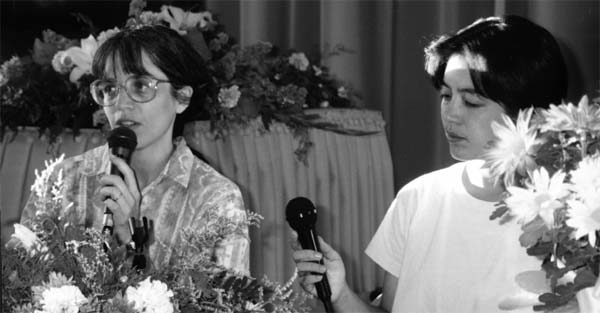
Terri
Nicholson and Shari (right) speak at cremation ceremonies
for Master Hua, July 1995 Photo by Marion Robertson


